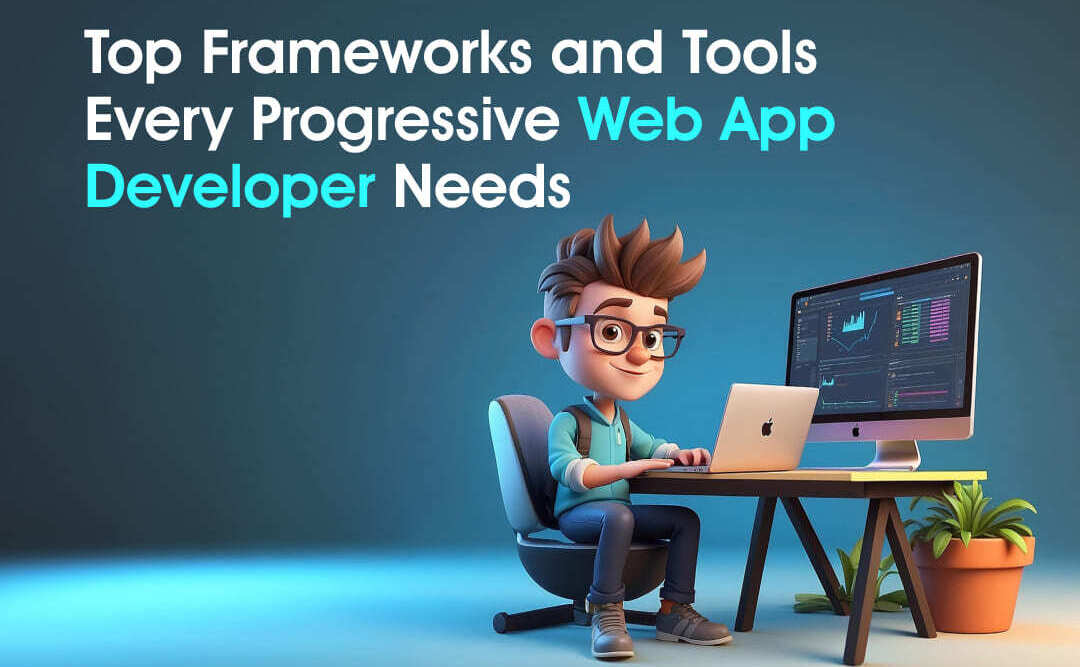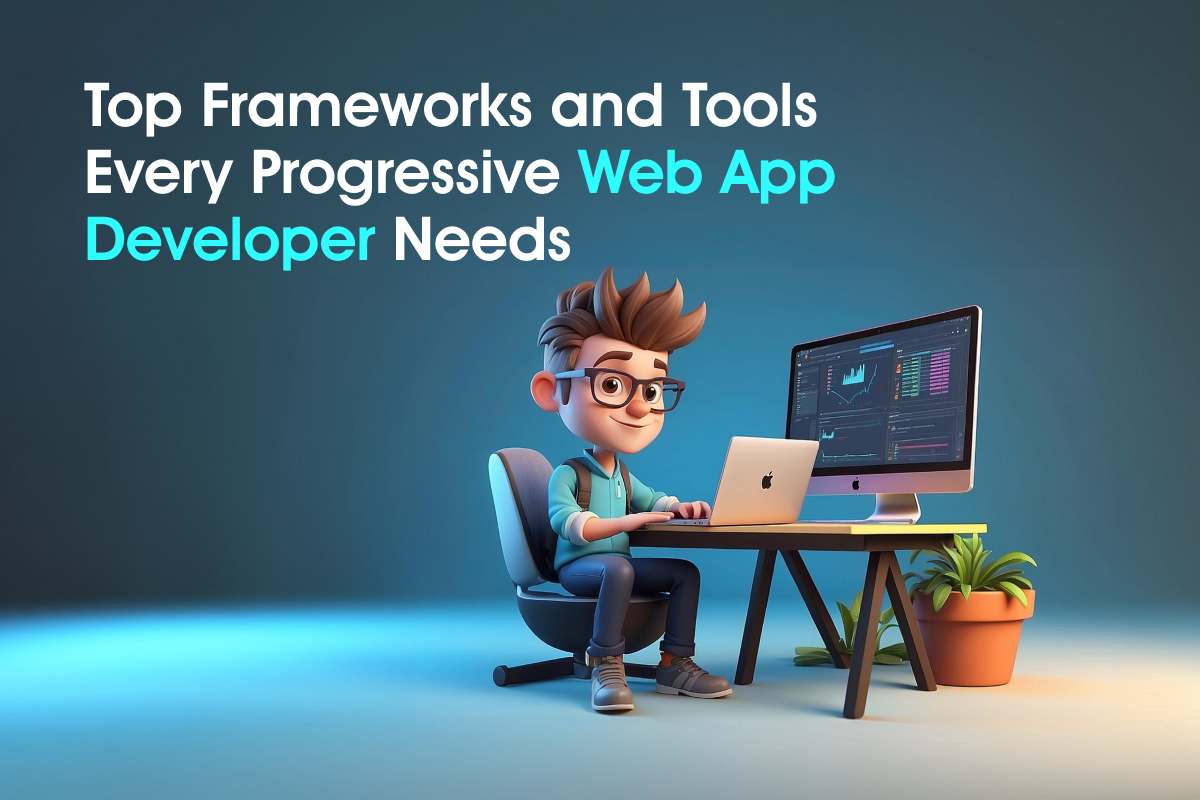Top Frameworks and Tools Every Progressive Web App Developer Needs
 Fenil Kasundra
Fenil Kasundra

What is a Progressive Web App (PWA)?
Web applications are being transformed by PWAs. Created with modern web technologies, they provide a native mobile application experience for users. This means that even if there is no internet or it is limited, they work at a high speed and give you engaging services.
Importance of Frameworks and Tools for PWA Development
Creating excellent PWAs requires a combination of strong frameworks and effective tools. These essential components help to streamline development, improve performance, and ensure optimal user experiences. With the right framework and toolset, developers can tremendously shorten PWA development time while keeping quality high.
Blog Overview
This comprehensive guide takes us through the world of PWA development to examine the key frameworks as well as tools that every developer must master. Whether you’re learning about PWA basics or implementing more complex features, this blog will arm you will all the necessary knowledge and resources to develop outstanding web apps. We’ll look into topics like The PWA ecosystem; Angular, React, Vue.js – Essential frameworks; Tools you need for Development; Optimization techniques; and Best practices.
Let’s embark on this journey together to discover the building blocks of successful PWAs.
Understanding the PWA Ecosystem
Core Web Vitals
Google uses Core Web Vitals to evaluate users’ website experience on its platform. They play an indispensable role in driving user satisfaction and search engine rankings hence their importance for PWAs. The three primary Core Web Vitals include:
Largest Contentful Paint (LCP): Measures how much time it takes for the critical content of a page to load.
First Input Delay (FID): Measures interaction time taken by browsers from when pages are landed on by users.
Cumulative Layout Shift (CLS): This metric shows how many visual instabilities occur during loading.
With proper optimization towards Core Web Vitals, your PWA will load in a flash, respond quickly, and provide an epic user experience.
Service Workers
Service workers are separate script files that work in the background and not as part of the main page thread. These enable features such as offline functionality, push notifications, and background sync. In PWAs, service workers have an essential role to play when it comes to improving user experience and ensuring its availability.
Key responsibilities of service workers include:
Caching assets: Saving static assets on user’s devices in order to improve loading speed and enable working offline.
Intercepting network requests: Deciding how network requests should be processed sometimes leads to caching strategies or even offline responses.
Push notifications: Sending notifications even when users aren’t active.
Background sync: Holding back network requests until connectivity is restored whereupon they are retried once again.
Manifest File
A manifest file holds metadata about a PWA which is provided by JSON (JavaScript Object Notation). It tells browsers about the name of an application, its icons, starting URL among other important details. This file is what makes it possible for users to add your web app to their home screens just like any other native application.
Key properties of a manifest file include:
name: The name of the app or website.
short_name: A shorter version of the app or site's name.
icons: Different sizes of icons for various devices.
start_url: The very first URL opened when launching a given progressive web application.
display: Specifies how the app should be displayed (fullscreen, standalone, minimal-ui).
background_color: The color of the background when the app is launched.
theme_color: The color of the UI in an app.
If you design the manifest file properly, it is possible to develop a very attractive and interesting PWA.
Essential Frameworks for PWA Development
Selecting an appropriate framework is important in building effective and scalable PWAs. These are some of the most popular options you can consider:
Angular
In order to build more complicated PWAs, Angular provides a powerful JavaScript framework that was developed and is being maintained by Google. TypeScript integration, dependency injection, and component-based architecture are the attributes that make Angular outstanding. In this case, one can be able to create applications that not only work well but also have enhanced performance levels.
Key Features:
TypeScript support for enhanced type safety
Comprehensive CLI for project setup and management
Reactive forms for efficient form handling
Angular Material for pre-built UI components
Strong community and extensive ecosystem
Benefits:
Development of large-scale applications
Improved code quality and maintainability
Strong performance and scalability
Rich set of features and tools
Use Cases:
Enterprise applications
Single-page applications (SPAs)
Progressive Web Apps (PWAs)
Need a robust PWA? Hire AngularJS Developers from our team to harness the full potential of Angular for your project.
React
React is a widely used JavaScript library that was built by Facebook to help developers in creating user interfaces. Although it isn’t exactly considered a full-fledged framework, it lays the groundwork well when crafting PWAs. React’s virtual DOM-based architecture for components handles its efficiency making it flexible enough to use JSX syntax enabling high output with little effort.
Key Features:
Virtual DOM for optimized performance
Component-based architecture
JSX for declarative UI development
Large and active community
Advantages:
Fast rendering and updates
Reusable components
Strong ecosystem of libraries and tools
Flexibility and scalability
Suitability for PWAs: React's component-based approach aligns well with PWA development principles. Its performance optimizations and ability to handle complex UIs make it a suitable choice for building engaging PWAs.
Vue.js
Vue.js represents a progressive JavaScript framework that combines simplicity with features. Developers new to frameworks often choose Vue.js because of its accessible API, incremental adoption, etc..
Overview:
Intuitive API and easy-to-learn
High performance due to virtual DOM
Component-based architecture
Reactive data binding
Features:
Vue CLI for project setup
Vue Router for navigation
Vuex for state management
Performance: Vue.js is known for its excellent performance, making it a strong contender for PWA development.
Use Cases: Vue.js is suitable for a wide range of projects, including small-scale PWAs, single-page applications, and complex web applications.
Other Notable Frameworks
Angular, React, or Vue.js are the three major frameworks but there are others such as Ionic, Ember, or Svelte.
Svelte: This system is known for using compilers which makes Svelte efficient in terms of codes.
Ember: Being an experienced framework this one focuses more on convention rather than configuration.
Ionic: This hybrid app development tool can also be used in creating PWAs.
The best framework choice relies on the following factors; project requirements, team expertise, and desired features.
Critical Tools for PWA Development
Lighthouse
Lighthouse is an open-source automation tool to improve the quality of web pages. It is essential when developing a PWA since it provides information about its speed, accessibility features/practices as well as search engine optimization (SEO). One can use Lighthouse audits to identify areas that need improvement in order to optimize their PWAs accordingly.
Key Metrics:
Performance: measures how quickly content loads on pages and how response time was.
Accessibility: Evaluate how easily people with disabilities can use the page.
Best Practices: looks out common issues on both the performance and accessibility side.
SEO: Assesses on-page SEO factors.
To use Lighthouse, you can:
Run it from Chrome DevTools.
Use the Lighthouse extension.
Make it a part of your CI/CD pipeline.
Webpack
It is very important to understand how Webpack works and its significance in the development of PWAs. The technology bundles JavaScript, CSS, and other assets into optimized bundles which makes the application load faster. Webpack also supports code splitting which allows lazy loading of components thus improving performance further.
Key Features:
Ability to bundle modules and optimize them.
Splitting up codes for better performance.
Supports loaders for various file types.
Plugin system for customization.
By effectively utilizing Webpack, developers can create efficient and maintainable PWA builds.
Testing Tools
To ensure the high quality and reliability of PWAs, thorough testing is essential. There are several testing tools available that cater to different aspects of the PWA development process.
Importance of Testing:
Early detection of defects and bugs during developing stages.
Influences good coding practices and maintainability levels.
Ensures optimum performance as well as user experience satisfaction.
Popular Testing Frameworks:
Jest: Simple JavaScript testing framework with fast speeds.
Mocha: Flexible, extensible testing framework designed for all types of tests.
Cypress: User interaction simulation end-to-end testing tool.
These tools help to write unit tests, integration tests as well as end-to-end tests to verify whether PWA components or functionalities behave correctly.
Deployment Tools
After developing and testing a PWA, it needs to be deployed on a web server. Fortunately, there are deployment tools that make this entire process easy to handle smoothly without complicated steps involved.
Tools for Deploying PWAs:
Firebase: A platform that hosts PWAs offers hosting services, and database services among other things like authentication services.
Netlify: A static site generator that comes with built-in continuous deployment and serverless functions.
AWS Amplify: A platform for building full-stack web and mobile applications including PWAs.
To ensure efficient delivery of PWA, these tools have functionalities like automatic build, deployment pipeline, content delivery network (CDN), and performance optimization.
By leveraging on these tools, developers can streamline the process of developing PWAs and create high-quality applications.
Advanced PWA Development
For true mastery of PWA development, one must delve into advanced techniques and best practices. In this section, we will dive into some key areas:
Performance Optimization Techniques
While we’ve emphasized basic performance optimization there are more strategies to enhance your PWA’s speed and responsiveness:
Image optimization: This is compressing images without compromising on their quality.
Code splitting: This involves breaking down code into smaller parts so that it can be loaded lazily.
Preloading resources: Involves fetching critical resources in advance.
Server-side rendering (SSR): This is rendering HTML on the server to enhance initial load time by improving its performance when requested by users.
Leveraging browser caching: Appropriate use of browser cache for static assets.
Offline Capabilities
PWAs are characterized by providing an uninterrupted experience even when offline. Offline functionality implementation should be based on the following principles:
Strategic caching: Caching data that is necessary for running applications as well as required resources.
Offline first approach: By default designing the app to work offline.
Informative offline page: Displaying clear instructions and guidance.
Resynchronization: Updating data once the connection has been reestablished after repair or maintenance activities.
Push Notifications
Delivering timely updates and alerts push notifications significantly help boost user engagement. Here is how you can implement them effectively:
Permission request: This lets the user opt-in to notifications.
Subscription management: Since users should be able to control their notification preferences.
Crafting compelling messages: Writing clear and actionable notifications.
Leveraging analytics: Tracking notification performance and optimizing campaigns.
Security Best Practices
This includes measures that ensure user data is safeguarded and the application remains secure. These security practices include:
HTTPS: It ensures safe communication with the server.
Content Security Policy (CSP): this prevents Cross-Site Scripting (XSS) and other attacks on web applications.
Regular security audits: Identifying and addressing vulnerabilities.
Data encryption: Safeguarding sensitive data through encryption.
User authentication: Implementing strong user authentication mechanisms.
By mastering these advanced techniques, you can create exceptional PWAs that deliver outstanding performance, reliability, and user engagement.
Conclusion
To build great PWAs strategic combination of frameworks and tools is needed. Angular, React, and Vue are three frameworks we identified as being suitable for different project requirements. We also discussed essential tools like Lighthouse, Webpack, testing frameworks, and deployment platforms all meant to improve the development process and increase PWA quality in general.
The PWA landscape is always changing with new technologies and best practices emerging from time to time. Staying ahead means that developers have to constantly learn what’s new in their field of expertise. Building PWAs that offer innovative experiences is achieved by following the latest trends.
Are you ready to start your PWA journey? Our experienced team specializes in building high-performance & engaging PWAs using AngularJS. Let us help you create a truly remarkable user experience on your web app today. Fill out our contact form now so we can discuss your project needs and see how we can be of service towards achieving them.
Hire AngularJS Developers from our company to unlock the full potential of your PWA.
Subscribe to my newsletter
Read articles from Fenil Kasundra directly inside your inbox. Subscribe to the newsletter, and don't miss out.
Written by
